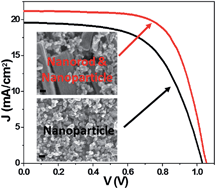Mesoporous scaffolds based on TiO2 nanorods and nanoparticles for efficient hybrid perovskite solar cells†
Abstract
In a mesoporous hybrid perovskite solar cell (PSC), the mesoporous scaffold plays key roles in controlling the crystallization of the perovskite material and in the charge carrier transport, and hence is critical for developing highly efficient PSCs. Here we report a study on blending micrometer-long TiO2 nanorods (NRs) into the commonly used nanoparticles (NPs) to optimize the mesoporous structure, with the aim of enhancing the perovskite material loading and connectivity as well as light harvesting. It was found that with 5–10% of NR incorporation, a uniform scaffold can be spin-coated and the PSC performance was improved. In comparison to the pure NP-based device, the power conversion efficiency was increased by about 27% when 10% of the NRs were incorporated, due to enhanced light harvesting and charge collection. However, with more NR blending, a homogeneous scaffold cannot be formed, resulting in PSC performance degradation. These findings contribute to a better design of mesoporous scaffolds for high-performance PSCs.


 Please wait while we load your content...
Please wait while we load your content...